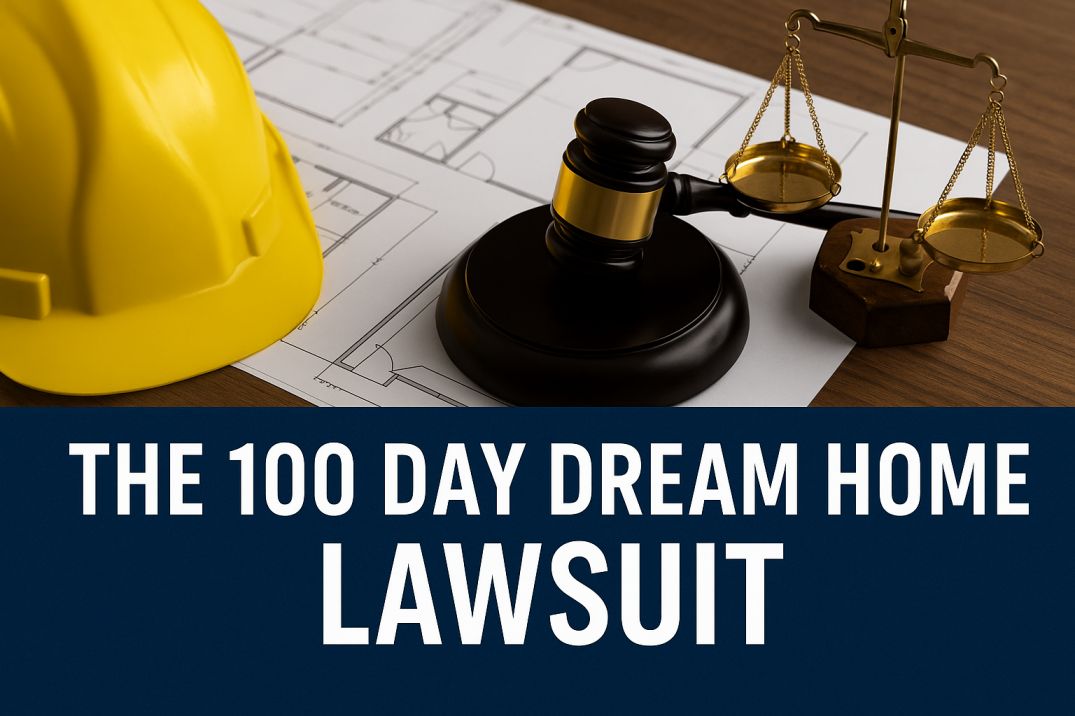100 Day Dream Home became a popular hit on HGTV. Viewers loved the fast-paced builds, stylish homes, and heartfelt moments. The show promised to turn empty lots into custom dream houses in just 100 days. Every episode followed a new couple hoping for a fresh start. The hosts, Brian and Mika Kleinschmidt, handled the design and construction. Their energy, teamwork, and on-screen chemistry pulled in fans across the country.
The concept felt bold. Building a home in 100 days seemed almost impossible. Still, the show made it look smooth and easy. Families watched their dream homes rise on screen, from blueprints to final touches. The series built a strong reputation and gained a loyal following. Social media buzzed after each episode. Viewers believed in the speed, skill, and style of the homes.
Now, the story has taken a sharp turn. Several former participants say the dream fell apart. They claim their homes were late, poorly built, or not what was promised. Some spent extra money fixing major problems. Others say they felt misled from the start.
Lawsuits soon followed. These legal battles uncovered serious complaints. The show’s image of perfection now faces questions about honesty, quality, and trust. This article breaks down the case. It explains the key issues, the homeowner claims, and what this could mean for reality home shows.
What Sparked the Lawsuit
The show launched in 2019. Viewers loved the speed and style. Each episode followed a couple building a new home from scratch. The timeline always stayed fixed at 100 days.
Several homeowners later spoke out. They said their homes didn’t meet expectations. Some homes were not ready in 100 days. Others had problems such as weak construction and missing features.
These claims led to legal action. The lawsuit quickly drew public attention.
Main Complaints from Homeowners
Breach of Contract
Homeowners signed clear agreements. The documents included deadlines, material details, and costs. The builders failed to finish homes on time. Delays added costs. Rent, storage, and extra fees piled up.
Clients felt cheated. The delays broke the terms set in writing. Many demanded payment for extra expenses.
Misrepresentation
The show created a polished image. Every episode showed happy clients, smooth construction, and flawless results. Viewers saw luxury finishes, bright spaces, and excited families. This built strong expectations.
Homeowners trusted what they saw. They believed the process would match the promises. They expected quality, speed, and care. What they got shocked them. Some homes looked rushed. Others missed key features. A few had clear signs of careless work.
Many felt the show misled them. The final product didn’t match the previews. They noticed cheaper materials, design changes, and poor craftsmanship. That gap between what was shown and what was delivered raised serious concerns.
The claims in the lawsuit say the show didn’t just stretch the truth—it crossed a line. Families say they would not have joined the show if they knew the real risks. This mismatch between promise and result led to strong accusations of false representation.
Poor Construction
Owners noticed big flaws. Pipes leaked. Wires failed. Floors felt uneven. They blamed the 100-day rush. Speed replaced care. Builders ignored details.
The problems raised safety concerns. Homeowners had to pay for repairs themselves.
False Advertising
The lawsuit also points to misleading ads. Trailers and social media promised dream homes. The final results didn’t match the hype.
Viewers saw custom finishes and perfect layouts. Participants received cut corners and generic builds. This hurt trust in the brand.
Delays and Extra Costs
Materials didn’t arrive on time. Workers missed schedules. Weather slowed progress. These delays pushed projects past the 100-day goal.
Contracts didn’t always cover these problems. Families had to pay out of pocket. Surprise charges added stress. Delays also disrupted plans and routines.
Who Is Involved
The homeowners filed the lawsuit. They claim financial loss, emotional stress, and broken trust.
The producers, contractors, and network face legal pressure. They argue outside issues caused the delays. They mention supply shortages and bad weather. The court will decide who holds fault.
Legal Process So Far
The case remains open. Courts are reviewing evidence. Lawyers from both sides have exchanged documents. They’ve shared photos, emails, and contracts.
Judges will hear testimonies from builders and participants. These stories will shape the verdict. The court could order repairs, refunds, or fines.
What This Means for Reality Shows
This case isn’t unique. Other shows have faced similar problems. Property Brothers also saw complaints from homeowners.
These lawsuits reveal a pattern. TV builds can’t always match real-life timelines. Viewers now question what happens off-camera.
Networks may now face stricter rules. Producers may need clearer contracts. The industry may move slower but safer.
Advice to Future Homeowners
Always read every contract before signing. Make sure it lists clear deadlines, materials, and costs. Look for penalty clauses in case things go wrong. Ask direct questions. Don’t trust verbal promises.
Keep track of everything. Save emails, text messages, and photos of each stage. Write down what was said during meetings. Strong records help if problems come up later. Good documentation can protect your money and your rights.
Pick your builder wisely. Check reviews, visit past projects, and speak to former clients. Avoid builders who dodge questions or make vague statements. A smooth pitch does not always mean a smooth build.
Expect delays. Weather, permits, and supply issues can slow things down. Add buffer time into your schedule. Stay involved, but stay realistic. A well-built home takes more than speed. It takes patience, clear plans, and reliable people.
Conclusion
The 100 Day Dream Home lawsuit uncovered serious flaws in a show that once promised perfection. Families trusted the process. They expected clear timelines, skilled work, and honest delivery. Many got delays, poor finishes, and broken promises instead.
This case sends a strong message. Building a real home takes time, care, and proper planning. Rushing the job to meet a camera-friendly deadline often leads to mistakes. Families paid the price in stress, money, and disappointment.
Viewers now see the cracks behind the polished scenes. Reality shows must do more than entertain. They must deliver what they claim. The lawsuit may lead to better contracts, more honest advertising, and tighter checks on quality.
If shows want to keep their audience, they must earn trust—not just views. Homeowners deserve real results, not just a good edit. This case could reshape how networks, builders, and viewers see the world of televised home construction.




